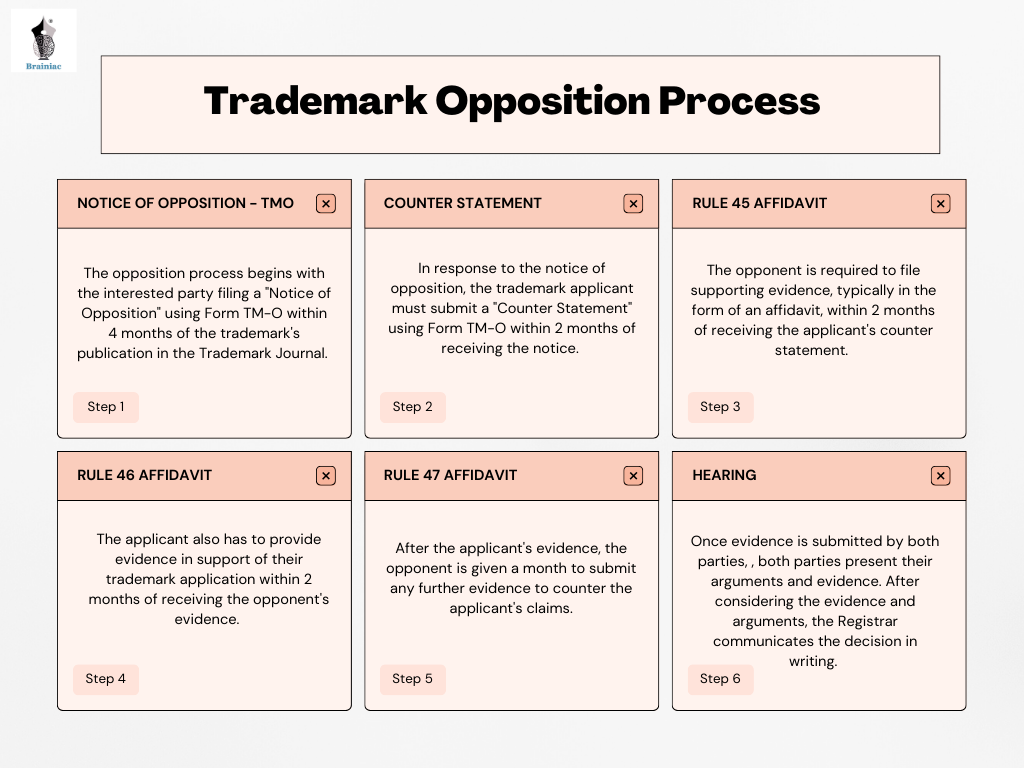Introduction
Registration of a trademark is essential for preserving the distinctiveness and exclusivity of a brand in the marketplace. However, obtaining a registered trademark is not always effortless. In India, there is a crucial stage known as “Trademark Opposition,” during which interested parties can express their concerns and objections against the registration of a trademark. Let’s delve into the intricacies of the trademark opposition process in India, step by step.
What is the Opposition Stage?
Trademark opposition is a legal procedure that allows third parties to object to the registration of a trademark that has been approved by the Trademark registry and published in the Trademark Journal. This phase provides a forum for those who believe that the registration of a specific trademark may infringe on their existing rights or violate legal provisions.
Grounds of Opposition
Opposition can be based on various grounds, including:
1. Similarity: One of the most common grounds for opposition is the similarity between the applied-for trademark and an existing registered trademark or a prior pending application. This similarity can lead to confusion among consumers, making it difficult to differentiate between the two marks. The objective here is to prevent the registration of a mark that could potentially infringe upon the rights of the owner of the existing mark.
2. Prior Rights: Opposition can be based on the existence of prior rights, which can include earlier trademark registrations, well-known marks, and even unregistered marks with significant reputation and usage. If the opponent can demonstrate that they have established rights in a similar or related mark before the filing date of the opposed application, they can raise opposition to protect their pre-existing rights.
3. Deceptiveness: Trademark applications that are likely to deceive or mislead the public in some way can face opposition. This could involve trademarks that falsely describe the nature, quality, or geographical origin of the goods or services, leading consumers into making incorrect assumptions about the products.
4. Genericness: Generic terms or commonly used words that describe a category of products or services cannot be registered as trademarks. If an applied-for mark is deemed generic, it can be opposed on the grounds that it lacks the distinctiveness necessary for trademark protection.
5. Well-Known Marks: If a mark is well-known in India and enjoys a substantial reputation, opposition can be raised against a similar or identical mark, even if it is meant for different goods or services. This is to prevent dilution of the well-known mark’s distinctiveness and protect it from unauthorized use.
6. Offensive or Contrary to Public Policy: Trademarks that are considered offensive, immoral, or against public policy can be opposed. This includes marks that promote hate speech, obscenity, or anything that goes against accepted social norms.
7. Geographical Indications: Geographical indications (GIs) are indications that identify goods as originating from a particular territory where a given quality, reputation, or other characteristic of the goods is essentially attributable to their geographical origin. If a trademark application includes a geographical indication without proper authorization, it can be opposed.
8. Bad Faith: If an opponent can establish that the applicant filed the trademark application in bad faith, with the intention of benefiting from another’s reputation or exploiting a known mark’s goodwill, they can raise opposition on this ground.
9. Prohibited Marks: Certain categories of marks are prohibited from registration, including marks that are descriptive of the goods or services, marks that are common surnames, marks that are generic, and marks that lack distinctiveness. Opposition can be raised if the applied-for mark falls under these prohibited categories.
Who Can Oppose?
Any interested party, including individuals, businesses, or legal entities, can oppose a trademark application. They need to establish their legal standing and interest in the matter.
Notice of Opposition and Counter Statement
Notice of Opposition (Rule 42): The opposition process begins with the interested party filing a “Notice of Opposition” using Form TM-O within 4 months of the trademark’s publication in the Trademark Journal. This notice should include the opponent’s details, grounds for opposition, and information about the trademark application they are opposing.
Counter Statement (Rule 44): In response to the notice of opposition, the trademark applicant must submit a “Counter Statement” using Form TM-O within 2 months of receiving the notice. This statement outlines the facts from the opposition notice that the applicant admits to and provides the basis for their defense.
Evidence and Documentation
Evidence in Support of Opposition (Rule 45): The opponent is required to file supporting evidence, typically in the form of an affidavit, within 2 months of receiving the applicant’s counter statement. Failure to file this evidence may result in the opposition being considered abandoned.
Evidence in Support of Application (Rule 46): The applicant also has to provide evidence in support of their trademark application within 2 months of receiving the opponent’s evidence. They can either rely on their counter statement or present additional evidence.
Evidence in Reply by Opponent (Rule 47): After the applicant’s evidence, the opponent is given a month to submit any further evidence to counter the applicant’s claims.
Hearing Process
Notice of Hearing: Once evidence is submitted by both parties, the Registrar schedules a hearing and notifies the parties. The hearing date is set at least one month after the notice.
Adjournment of Hearing: Either party can request a maximum of two adjournments, each not exceeding 30 days, by submitting an application (Form TM-M) and paying the prescribed fee.
Hearing Proceedings: During the hearing, both parties present their arguments and evidence. The Registrar ensures an equal opportunity for both sides to present their case.
Registrar’s Decision: After considering the evidence and arguments, the Registrar communicates the decision in writing. If either party fails to attend the hearing, the application or opposition may be treated as abandoned.
Objection v. Opposition
The objection stage and opposition stage are distinct phases of the trademark submission and registration procedure in India. Following the submission of a trademark registration, the Trademark Registry examines the application for possible flaws, such as similarities with existing trademarks and compliance with legal requirements. Objections are voiced if discrepancies are discovered, allowing the applicant to address these concerns.
Conversely, the opposition stage occurs after the publication of the trademark in the trademark journal and the approval of the trademark by the Trademark registry. During this phase, individuals who believe the trademark may impinge on their existing rights may file a formal opposition. They must provide reasons and evidence to support their opposition. The applicant then has the opportunity to present counter arguments and supporting evidence in defence of the trademark.
In a nutshell the objection stage entails an evaluation of the application by the Trademark registry, whereas the opposition stage allows external third parties to express objections to the registration of the trademark. Despite their apparent similarity, these phases serve distinct purposes in ensuring fair trademarks and preventing market confusion.



